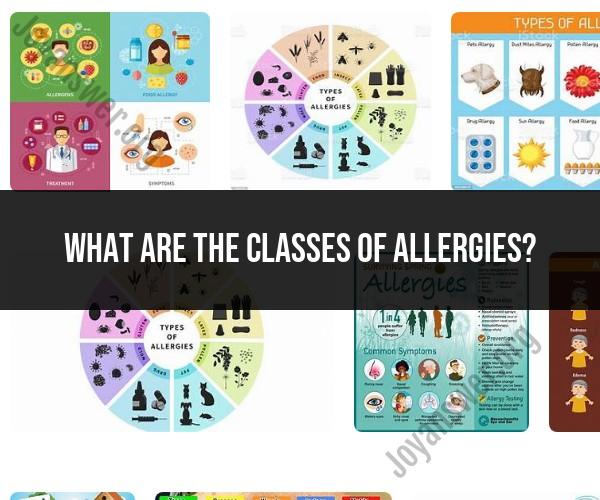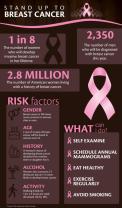What are the classes of allergies?
Allergies are hypersensitive immune responses to substances that are typically harmless to most people. Allergic reactions can vary in severity and manifest in different ways. Allergies are commonly classified into several classes based on the type of immune response and the substances or allergens involved. Here are the main classes of allergies:
IgE-Mediated (Immediate-Type) Allergies:
- These are the most common and well-known type of allergies. They occur when the immune system produces an excessive amount of immunoglobulin E (IgE) antibodies in response to exposure to an allergen.
- Examples: Allergic reactions to pollen, dust mites, pet dander, insect stings, certain foods (e.g., peanuts, tree nuts, shellfish), and latex.
Non-IgE-Mediated (Delayed-Type) Allergies:
- In these allergies, the immune response does not involve IgE antibodies. Instead, other immune cells, such as T cells, play a key role. These reactions typically take longer to develop than IgE-mediated allergies.
- Examples: Allergic contact dermatitis (e.g., skin reactions to poison ivy or certain chemicals), celiac disease (an autoimmune reaction to gluten), and some forms of drug allergies.
Mixed IgE and Non-IgE-Mediated Allergies:
- Some allergic reactions involve a combination of IgE-mediated and non-IgE-mediated mechanisms, making them more complex.
- Examples: Some types of food allergies, particularly in infants and young children, may involve both IgE and non-IgE pathways.
Drug Allergies:
- These allergies occur when the immune system reacts adversely to certain medications. Drug allergies can be IgE-mediated or non-IgE-mediated.
- Examples: Allergic reactions to antibiotics (e.g., penicillin), non-steroidal anti-inflammatory drugs (NSAIDs), and other medications.
Food Allergies:
- Food allergies involve an immune response to specific proteins found in certain foods. They can be IgE-mediated or non-IgE-mediated.
- Examples: Allergic reactions to common food allergens like peanuts, tree nuts, milk, eggs, soy, wheat, and fish.
Respiratory Allergies:
- These allergies affect the respiratory system and are often triggered by airborne allergens like pollen, dust mites, and pet dander.
- Examples: Allergic rhinitis (hay fever) and allergic asthma.
Insect Sting Allergies:
- These allergies occur in response to insect stings, such as those from bees, wasps, hornets, or fire ants. They can be IgE-mediated.
- Examples: Allergic reactions to insect stings can range from mild skin reactions to severe anaphylaxis.
Occupational Allergies:
- Some people develop allergies due to exposure to allergens in their workplace, such as chemicals, dust, or mold.
- Examples: Occupational asthma, allergic contact dermatitis in healthcare workers.
Latex Allergy:
- Latex allergies are reactions to proteins found in natural rubber latex products, such as gloves or balloons. They can be IgE-mediated.
- Examples: Allergic reactions to latex can range from skin irritation to severe anaphylaxis.
It's important to note that allergies can vary in severity, and not everyone who is exposed to an allergen will develop an allergic reaction. Allergies are diagnosed through clinical evaluation, including medical history, physical examination, and sometimes allergy testing. Treatment options may include allergen avoidance, medications (e.g., antihistamines, epinephrine for severe reactions), and allergen immunotherapy (allergy shots) for certain allergies. If you suspect you have allergies, it's advisable to consult with a healthcare professional or allergist for proper evaluation and management.
Allergy Classification: Understanding the Different Classes of Allergic Reactions
Allergic reactions are classified into four types, based on the underlying immunological mechanism:
- Type I allergies are immediate hypersensitivity reactions that occur within minutes to hours of exposure to the allergen. They are mediated by immunoglobulin E (IgE) antibodies, which bind to mast cells and basophils and trigger the release of histamine and other inflammatory mediators. Common type I allergies include food allergies, allergic rhinitis (hay fever), and allergic asthma.
- Type II allergies are cytotoxic reactions that occur when antibodies bind to allergens on the surface of cells and cause their destruction. Common type II allergies include drug allergies and autoimmune disorders such as Graves' disease and Hashimoto's thyroiditis.
- Type III allergies are immune complex reactions that occur when antibodies bind to allergens in the bloodstream and form immune complexes. These immune complexes can deposit in tissues and cause inflammation. Common type III allergies include serum sickness, drug allergies, and some autoimmune disorders.
- Type IV allergies are delayed hypersensitivity reactions that occur 24-72 hours after exposure to the allergen. They are mediated by T cells, which release cytokines that attract inflammatory cells to the site of exposure. Common type IV allergies include contact dermatitis, allergic reactions to nickel and other metals, and delayed reactions to tuberculin testing.
Categorizing Allergies: A Breakdown of Allergy Types
Allergies can also be categorized by the type of allergen involved:
- Food allergies are allergic reactions to food proteins. The most common food allergens are milk, eggs, peanuts, tree nuts, soy, wheat, fish, and shellfish.
- Inhalant allergies are allergic reactions to allergens that are inhaled into the lungs. The most common inhalant allergens are pollen, dust mites, mold, and pet dander.
- Insect sting allergies are allergic reactions to the venom of stinging insects, such as bees, wasps, yellow jackets, and fire ants.
- Drug allergies are allergic reactions to medications. The most common drug allergens include penicillin, other antibiotics, and aspirin.
- Skin contact allergies are allergic reactions to allergens that come into contact with the skin. The most common skin contact allergens include nickel, latex, and fragrances.
Allergy Variants: Exploring the Classes of Allergic Responses
Within each class of allergic reaction, there are different variants. For example, type I allergic reactions can be further divided into anaphylaxis, allergic rhinitis, and allergic asthma. Anaphylaxis is a severe, systemic allergic reaction that can be life-threatening. Allergic rhinitis is a common allergic condition that causes symptoms such as sneezing, runny nose, and itchy eyes. Allergic asthma is a chronic inflammatory lung disease that is triggered by allergens.
It is important to note that not everyone with an allergy will experience all of the possible symptoms or variants. The severity and type of allergic reaction can vary from person to person.
If you suspect that you or someone you know has an allergy, it is important to see a doctor or allergist for diagnosis and treatment.













